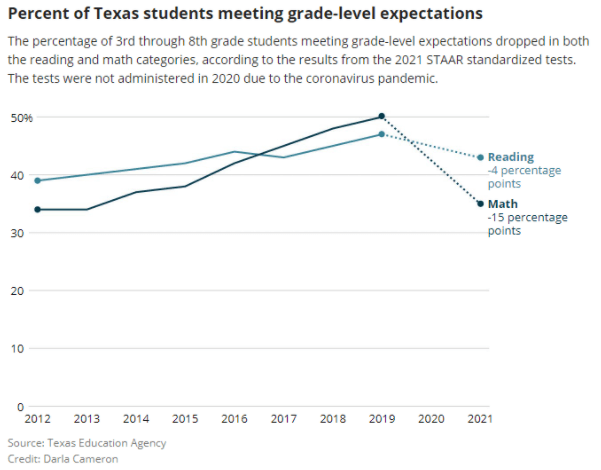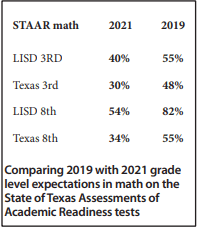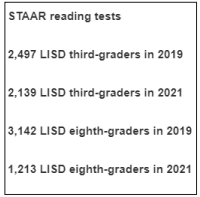
By RICHARD STONE, Hill Country News
Standardized test scores for Leander ISD suffered significant declines from the spring of 2019 to 2021, but nothing like those of other Texas school districts.
The results of the Spring 2021 State of Texas Assessments of Academic Readiness (STAAR) tests were released last week.
According to the Texas Education Agency (TEA), the drop was more significant in districts that had most of their instruction online, compared to districts with more in-person classes and math scores suffered the most.
There were no STAAR tests given in 2020.
“As a result of the learning disruptions caused by the COVID-19 pandemic, the number of students not meeting grade level increased from 2019 across all subject areas and grade levels, with English I and English II being the only exceptions,” the TEA said in a press release reporting the results.” As a subject area, mathematics reflects the largest decline in proficiency across all grade levels. Districts with a higher percentage of students learning virtually experienced a greater degree of decline.”
Only 40% of LISD third graders met math grade level expectations in the 2021 scores compared to 55% in 2019. Across the state, only 30% of third-graders met grade level expectations in 2021 compared to 48% in 2019.
Eighth-graders in LISD saw a similar decline in math scores with 54% meeting grade level expectations in 2021 compared to 82% in 2019. Statewide, only 35% of eighth graders met standards in 2021 compared to 55% in 2019.
Leander third-graders saw only a 1% drop in reading scores while eighth-graders suffered a 10% drop — about the same as eighth-graders statewide.
“Thankfully, from early on, Texas prioritized the availability of in-person instruction during this tremendously difficult year,” said Texas Education Commissioner Mike Morath.” When students come into Texas public schools, they are well-served by Texas educators—a fact that these scores confirm. But it is also painfully clear that the pandemic had a very negative impact on learning. I shudder to consider the long-term impact on children in states that restricted in-person instruction.”

According to the TEA press release, 85 percent of eligible students participated in grades 3-8 STAAR assessments, as compared to 96 percent in 2019. In high school, 92 percent of eligible students participated in EOC assessments, as compared to 97 percent in 2019. Overall STAAR participation in spring 2021 was 87 percent. Of those eligible students who did not participate in the assessment, there was a slightly higher concentration of economically disadvantaged students than of participating students.
Importantly, 2,497 LISD third-graders took the 2019 STAAR reading tests in 2019 while only 2,139 took the 2021 tests. 3,142 eighth-graders took the reading tests in 2019 compared to 1,213 in 2021.
Since 2012, test results in the state had been steadily improving, but after COVID-19 related disruptions, the percentage of students meeting reading expectations dropped back to 2016 rates and the percentage meeting math expectations dropped to 2013 passing rates.
Students who took the test in Spanish also saw “far more significant declines in rates of grade level” than those who took the test in English, Morath said.
“The data may be disheartening, but with it, our teachers and school leaders are building action plans to support students in the new school year,” Morath said. “Policymakers are using it to direct resources where they are needed most.”
Hill Country News has been serving Cedar Park, Leander and Northwest Austin since 1968.


